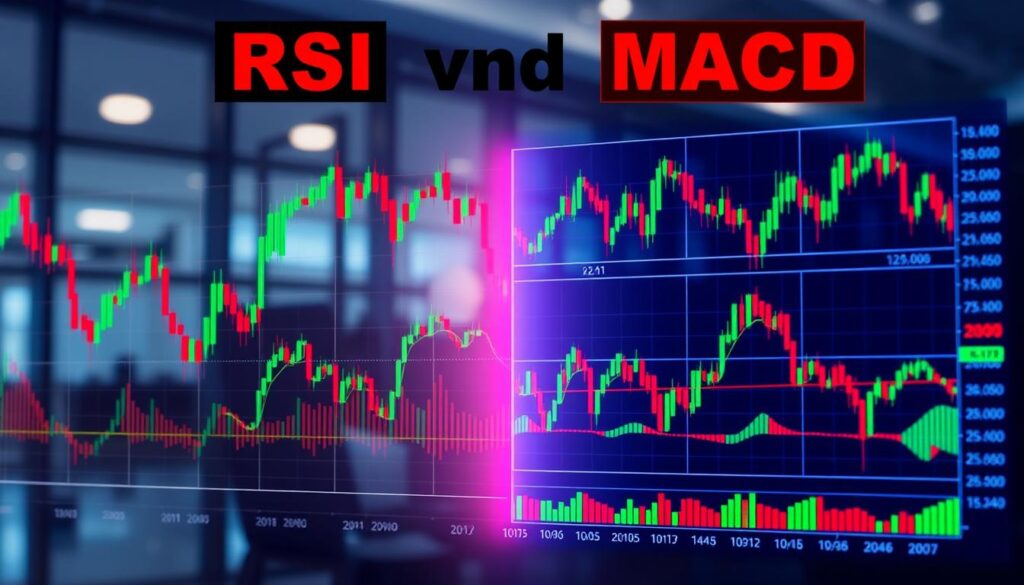Combining the Relative Strength Index (RSI) and Moving Average Convergence Divergence (MACD) indicators can lead to more effective trading strategies. Both RSI and MACD are highly effective momentum indicators used in technical analysis to identify trends and potential trading opportunities. Understanding how each of them works is crucial before using them in tandem as part of a trading strategy.
The RSI and MACD combination is a powerful tool in technical analysis, allowing traders to make more informed decisions. By using the MACD to identify trends and the RSI to confirm overbought or oversold conditions, traders can enhance signal reliability and potentially improve their overall trading performance. This approach is a key aspect of a successful trading strategy.
Table of Contents
Key Takeaways
- Combining RSI and MACD can enhance trading strategy effectiveness.
- Understanding both indicators individually is crucial before using them together.
- The RSI and MACD combination can help identify trends and potential trading opportunities.
- Using MACD to identify trends and RSI to confirm overbought or oversold conditions can improve signal reliability.
- A trading strategy that incorporates the RSI and MACD combination can potentially improve overall trading performance.
Understanding the Relative Strength Index (RSI)
The Relative Strength Index (RSI) is a momentum indicator used to measure the speed and change of price movements. It is an oscillator that ranges from zero to 100, with values above 70 indicating an overbought condition and values below 30 indicating an oversold condition. The RSI was introduced in 1978 by J. Welles Wilder Jr. as a tool to detect changes in momentum and potential price direction.
The RSI calculation involves the average gain and loss during a specified look-back period, typically set at 14 periods. This information helps traders identify overbought and oversold levels, which can be used to predict price behavior and validate trends. The Relative Strength Index is most effective in trading ranges rather than strong trending markets, making it a valuable tool for traders looking to identify potential buying or selling opportunities.
- RSI levels below 30 or above 70 are considered significant for indicating potential buying or selling opportunities.
- RSI readings can be modified to align with the trend direction, such as considering overbought levels lower than 70 during a downtrend and oversold levels higher than 30 during an uptrend.
- Traders can identify divergences between the RSI and price movement, such as bullish divergences indicating potential price increases and bearish divergences suggesting possible price declines.
By understanding how to use the Relative Strength Index as a momentum indicator, traders can gain valuable insights into market trends and make more informed trading decisions. The RSI is a powerful tool that can be used in conjunction with other indicators, such as the MACD, to create a comprehensive trading strategy.
Mastering the MACD Indicator
The Moving Average Convergence Divergence (MACD) is a trend indicator that measures the strength and speed of price movement. It is calculated as the difference between a 12-day and a 26-day exponential moving average, with a 9-day EMA used as the signal line. Understanding how to interpret MACD signals, including signal line crossovers, zero line crossovers, and divergences, is crucial for effective trading.
When the MACD line crosses above the signal line, it’s considered bullish, while a crossover below is bearish. High volume in trading confirms the strength of a price movement, while low volume can indicate a potential reversal or weak trend. The MACD indicator can be used in combination with other indicators, such as the RSI, to provide insights into market momentum and potential reversals.
- MACD line crossovers above the signal line indicate a bullish trend
- MACD line crossovers below the signal line indicate a bearish trend
- Zero line crossovers can indicate a change in market momentum
- Divergences between the MACD line and the price can indicate a potential reversal
By mastering the MACD indicator and combining it with other indicators, traders can gain a deeper understanding of market trends and make more informed trading decisions. The MACD indicator is a powerful tool for identifying trends and predicting price movements, and its use can be tailored to suit individual trading strategies and goals.
| Indicator | Description |
|---|---|
| MACD | Measures the difference between two moving averages |
| Signal Line | A 9-day EMA used to generate buy and sell signals |
| RSI | Measures the magnitude of recent price changes |
The Power of Using RSI and MACD Together
Combining the Relative Strength Index (RSI) and Moving Average Convergence Divergence (MACD) indicators can significantly enhance trading strategies. The RSI MACD strategy involves using both indicators to confirm trading signals, reducing the likelihood of false signals. By analyzing the RSI and MACD together, traders can gain a more comprehensive understanding of market trends and make more informed decisions.
The key to this combined indicator analysis is to identify the complementary aspects of both indicators. The RSI provides insight into overbought and oversold conditions, while the MACD offers trend direction and momentum insights. By using one indicator to confirm signals from the other, traders can increase the accuracy of their trading decisions. For example, when the MACD signal line crosses above the MACD line and the RSI is below 30, it suggests a strong buying opportunity.
Confirmation Signals
Trading signal confirmation is a critical aspect of the RSI MACD strategy. By combining the signals from both indicators, traders can reduce the risk of false signals and increase the potential for profitable trades. The following are some examples of confirmation signals:
- MACD line crossing above the signal line and RSI below 30, indicating a buying opportunity
- MACD line crossing below the signal line and RSI above 70, indicating a selling opportunity
Divergence Detection
Divergence detection is another important aspect of the RSI MACD strategy. By analyzing the relationship between the RSI and MACD, traders can identify potential divergences between price action and momentum. This can provide valuable insights into potential trend reversals or continuations. For example, if the price is in an uptrend and the MACD line is above the signal line while the RSI stays above 50, it indicates a strong bullish trend.
Setting Up Your Trading Charts
To effectively use the RSI and MACD indicators, it’s essential to set up your trading charts correctly. This involves choosing the right timeframes and adjusting the indicator parameters to suit your trading strategy. Multiple timeframe analysis is crucial in identifying trends and making informed trading decisions.
A common approach is to use a daily chart to determine the overall trend and an hourly chart to identify specific trading signals. The chart setup should include the RSI and MACD indicators, with the RSI parameters set to 14 and the MACD parameters set to 12, 26, and 9.
Here are some tips for setting up your trading charts:
- Use a daily chart to determine the overall trend
- Use an hourly chart to identify specific trading signals
- Adjust the RSI parameters to 14
- Adjust the MACD parameters to 12, 26, and 9
By following these steps and using multiple timeframe analysis, you can create a effective chart setup that helps you make informed trading decisions.
Key Entry Signals When Combining RSI and MACD
When combining the Relative Strength Index (RSI) and Moving Average Convergence Divergence (MACD) indicators, traders can identify high-probability trade entry strategies. The RSI measures market momentum, with levels above 70 indicating overbought conditions and levels below 30 indicating oversold conditions. The MACD, on the other hand, helps confirm the strength of trends.
A bullish scenario occurs when the RSI breaks above 30 from below, and the MACD shows a bullish crossover. In this case, a trader can enter a long position. Conversely, a bearish scenario occurs when the RSI breaks below 70 from above, and the MACD shows a bearish crossover, indicating a short position.
Traders can use momentum confirmation to validate their trade entries. For example, if the daily chart confirms an upward trend and the RSI breaks above 30, a trader can confidently open a long position. The following table illustrates some common trade entry strategies:
| Scenario | RSI Level | MACD Crossover | Trade Entry |
|---|---|---|---|
| Bullish | Above 30 | Bullish | Long position |
| Bearish | Below 70 | Bearish | Short position |
By combining the RSI and MACD indicators, traders can create effective trade entry strategies and increase their chances of success in the markets.
Exit Strategies Using Both Indicators
Effective exit strategies are crucial for successful trading, and using RSI and MACD in combination can help determine optimal exit points. To set profit targets, traders can use RSI levels and MACD histogram peaks. For example, when the RSI reaches overbought levels (above 70) and the MACD histogram peaks, it may be a good time to take profits.
Stop losses are usually located at either the previous extreme or at the edge of the signal candle, depending on your trading style. Risk management is essential in trading, and using RSI and MACD can help traders manage their risk. By setting stop losses based on these indicators, traders can limit their potential losses.
Here are some key points to consider when using RSI and MACD for exit strategies:
- Use RSI levels to set profit targets
- Use MACD histogram peaks to confirm trade exit signals
- Set stop losses based on previous extremes or signal candle edges
- Use trade exit techniques such as trailing stops to maximize profits
Traders can also use position scaling techniques, such as partial profit-taking when RSI reaches overbought/oversold levels while maintaining core positions based on MACD trends. By combining these strategies, traders can develop effective exit strategies that help them maximize their profits.
| Indicator | Signal | Action |
|---|---|---|
| RSI | Overbought (above 70) | Take profits |
| MACD | Histogram peak | Confirm trade exit signal |
| RSI and MACD | Divergence | Exit trade |
Trading in Different Market Conditions
When it comes to trading, understanding the current market conditions is crucial for making informed decisions. In trend trading, the MACD indicator can help identify the overall trend direction, while the RSI can signal potential entry points. For instance, a buy condition can be triggered when the MACD fast line crosses the slow line and the RSI is below 40, indicating an oversold condition.
In range-bound markets, the RSI is particularly useful for identifying points of reversal. By monitoring the RSI levels, traders can gauge when the market is overbought or oversold, and adjust their strategies accordingly. On the other hand, the MACD may not be as effective in range-bound markets, as it can produce false signals due to the whipsaw effect.
In high-volatility environments, volatility analysis becomes essential. Traders need to adjust their indicator settings and interpret signals in the context of fast-moving markets. By combining the RSI and MACD indicators, traders can gain a more comprehensive understanding of market conditions and make more informed trading decisions.
Some key considerations for trading in different market conditions include:
- Using the RSI for mean reversion trades in range-bound markets
- Adjusting MACD settings for high-volatility environments
- Monitoring RSI levels for overbought and oversold conditions
By understanding how to adapt the RSI and MACD strategy to various market conditions, traders can improve their chances of success in trend trading and range-bound markets, and make more informed decisions in high-volatility environments through careful volatility analysis.
Common Mistakes to Avoid
When using the RSI and MACD combination, traders often fall into common pitfalls that can hinder their trading performance. One of the primary trading pitfalls is over-reliance on indicators, which can lead to neglect of other essential analysis methods. This can result in poor risk control, as traders may ignore stop losses or take oversized positions based solely on indicator signals.
Another critical aspect to consider is indicator limitations. The RSI, for instance, ranges from 0 to 100, with above 70 indicating overbought conditions and below 30 indicating oversold conditions. However, these levels can be affected by market volatility, making it essential to combine the RSI with other indicators like the MACD to confirm signals. The MACD can identify bullish and bearish crossovers, providing a more comprehensive view of market trends.
To avoid these mistakes, traders should focus on risk control by risking 1-2% of their trading capital per trade. They should also combine the RSI and MACD with price action analysis to gain a more accurate understanding of market trends. Some key points to keep in mind include:
- Avoid overtrading by combining indicators from different categories
- Use the RSI to evaluate overbought or oversold conditions
- Confirm signals using both the RSI and MACD
- Plan entry and exit points based on confirmed signals
By being aware of these common mistakes and taking steps to avoid them, traders can refine their approach and improve their overall trading performance, ultimately achieving better risk control and avoiding trading pitfalls.
Advanced Combination Techniques
For experienced traders, combining RSI and MACD indicators offers a powerful approach to identifying trend reversals and optimizing trading strategies. By analyzing indicator divergences, traders can uncover discrepancies between price action, RSI, and MACD, which can signal significant trend changes. Multiple timeframe analysis is also essential, as it provides a more comprehensive view of market conditions, allowing traders to make informed decisions.
A key aspect of advanced combination techniques is creating custom indicator settings tailored to specific trading styles or market conditions. This personalized approach enables traders to optimize their strategies and potentially improve performance. By incorporating indicator divergences and multiple timeframe analysis into their trading plans, traders can enhance their confidence in their strategies and make more effective decisions.
- Improved risk management
- Enhanced trading confirmations
- Increased flexibility in responding to changing market conditions
By leveraging these advanced combination techniques, traders can refine their strategies and achieve better trading outcomes.
Real-World Trading Examples
When applying the RSI and MACD combination in real-world trading, it’s essential to consider various market scenarios. Through case studies, traders can gain valuable insights into how these indicators perform in different conditions. By analyzing trade analysis from experienced traders, one can develop a deeper understanding of how to effectively use the RSI and MACD together.
In a bullish setup, for instance, the RSI might bounce from oversold levels while the MACD shows positive divergence, indicating a potential buying opportunity. On the other hand, a bearish setup could involve overbought RSI and MACD bearish crossovers, signaling a potential sell signal. Understanding these scenarios through case studies can significantly enhance a trader’s ability to make informed decisions.
By examining different market scenarios and applying trade analysis, traders can refine their strategies to better suit their needs. Whether dealing with ranging markets or trending conditions, the combination of RSI and MACD provides a powerful tool for identifying potential entry and exit points. Through careful consideration of case studies and market analysis, traders can develop a more comprehensive approach to trading, ultimately leading to more successful outcomes.
Risk Management Guidelines
Effective risk management is crucial for long-term trading success. When using the RSI and MACD indicators, it’s essential to consider position sizing to maximize returns while minimizing losses. This involves adjusting the size of your trades based on the strength of the signals generated by the indicators.
A key aspect of risk management is setting risk-reward ratios that align with your trading goals. By using the RSI and MACD indicators, you can determine the potential risk and reward of each trade and adjust your position size accordingly. For example, if the RSI indicates an oversold condition and the MACD histogram is turning positive, you may want to increase your position size to take advantage of the potential upside.
Another critical aspect of risk management is drawdown management. This involves monitoring your account balance and adjusting your trading strategy to minimize losses during periods of market volatility. By using the RSI and MACD indicators, you can identify potential drawdowns and adjust your position size or exit the market temporarily to reduce your exposure to risk.
To implement effective risk management, consider the following strategies:
- Set clear risk-reward ratios for each trade
- Adjust position size based on the strength of the signals
- Monitor account balance and adjust trading strategy during periods of market volatility
By incorporating these risk management guidelines into your trading strategy, you can minimize losses and maximize returns when using the RSI and MACD indicators.
Building Your Trading Plan
Developing a comprehensive trading strategy is crucial for success in the markets. This involves trading strategy development, where you define your entry and exit rules, risk management protocols, and performance metrics to track your progress. A well-structured plan helps you stay focused and avoid impulsive decisions.
When building your trading plan, consider the following key elements:
- Clearly defined entry and exit rules based on RSI and MACD signals
- Position sizing and risk management strategies
- Performance metrics to track and evaluate your trading results
Regular review and adjustment of your trading plan are essential for continuous improvement. By monitoring your performance metrics and staying up-to-date with market conditions, you can refine your strategy and improve your trading outcomes.
Conclusion
As we conclude our exploration of leveraging the MACD and RSI indicators together, the key takeaway is the power of continuous learning and market adaptation. Successful traders understand that trading strategies are not static; they must evolve alongside the dynamic financial landscape. By combining the trend-identifying strengths of MACD with the momentum insights from RSI, you can develop a robust trading strategy that remains effective across various market conditions.
Remember, mastering this technique requires diligent practice, vigilant risk management, and a willingness to refine your approach. Stay committed to continuous learning and regularly review your trading plan to ensure it aligns with the market adaptation needed to navigate the ever-changing tides of the markets. The journey to trading excellence is an ongoing one, but by leveraging the powerful combination of MACD and RSI, you’ll be well on your way to consistent and profitable trades.
FAQ
What is the purpose of combining the Relative Strength Index (RSI) and Moving Average Convergence Divergence (MACD) indicators?
Combining the RSI and MACD indicators can lead to more effective trading strategies by providing a comprehensive analysis of market momentum and trend direction. The complementary nature of these indicators helps traders identify potential market reversals, continuations, and other valuable insights to enhance their trading decisions.
How does the Relative Strength Index (RSI) work as a momentum indicator?
RSI is a momentum indicator that calculates the ratio of a stock’s average gains and losses over a given timeframe. It measures market momentum by comparing average gains and losses, providing insights into overbought and oversold market conditions through key levels like 70 (overbought) and 30 (oversold).
What is the Moving Average Convergence Divergence (MACD) indicator and how does it function?
MACD is both a trend and momentum indicator that measures the relationship between two moving averages. It consists of the MACD line, signal line, and histogram, which provide signals on trend direction, line crossovers, and momentum divergences that can be used to identify potential market reversals or continuations.
How do the RSI and MACD indicators complement each other in trading strategies?
The combination of RSI and MACD can be powerful, as RSI provides overbought and oversold signals while MACD offers insights into trend direction and momentum. Traders can use one indicator to confirm signals from the other, potentially reducing false signals. The combination can also be effective in detecting divergences between price action and momentum, offering valuable clues about potential trend reversals or continuations.
How should traders set up their charts for effective RSI and MACD analysis?
Traders should consider recommended timeframes for their trading style, from day trading to swing trading and longer-term investing. Analyzing multiple timeframes is also important. Optimal parameter settings for both RSI and MACD can be adjusted to fine-tune the indicators for specific markets or trading strategies, and organizing chart layouts efficiently is crucial for effective analysis.
What are some key entry signal scenarios when using the RSI and MACD combination?
Traders can look for scenarios where RSI and MACD align to provide strong entry signals, such as when RSI moves out of oversold territory while MACD shows a bullish crossover. Both bullish and bearish setups can be identified, with MACD helping to confirm the strength of trends indicated by RSI.
How can traders use the RSI and MACD combination to determine optimal exit points?
Traders can use RSI levels and MACD histogram peaks to set profit targets. Strategies for placing stop losses can also be based on MACD signal line crossovers. Position scaling techniques, such as partial profit-taking when RSI reaches overbought/oversold levels while maintaining core positions based on MACD trends, can also be employed.
How can traders adapt the RSI and MACD strategy to different market conditions?
The RSI and MACD combination can be applied to various market conditions, such as trend trading where MACD identifies the overall trend direction, and range-bound markets where RSI can be used for mean reversion trades while MACD gauges trend strength. Techniques for high-volatility environments, including adjusting indicator settings and interpreting signals, can also be explored.
What are some common pitfalls to avoid when using the RSI and MACD combination?
Traders should be aware of potential false signals, such as RSI divergences that are not confirmed by MACD. Over-relying on indicators at the expense of other analysis methods and making risk management mistakes, like ignoring stop losses or taking oversized positions based solely on indicator signals, should also be avoided.
What are some advanced techniques for combining RSI and MACD?
More experienced traders can explore complex divergence analysis, where discrepancies between price action, RSI, and MACD can signal powerful trend reversals. Using these indicators across multiple timeframes for a more comprehensive market view and creating custom indicator settings tailored to specific trading styles or market conditions can also be considered.









